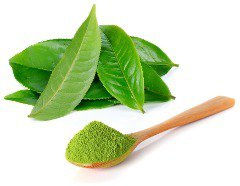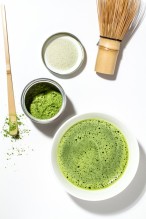Written by Jacqui Campbell, MS, RD, CDN
Ellie Krieger, dietitian and columnist for The Washington Post shared her predictions for five healthy foods that will make their mark on 2016 with her top food being matcha.

Matcha is stone ground green tea. Instead of steeping green tea leaves like regular green tea, the whole leaves are ground into a fine powder and mixed with water to make matcha drinks. In addition to the preparation being different, there are differences in the growing and harvesting of the tea leaves which produces significantly greater health benefits.
 Growing and Harvesting
Growing and Harvesting
In order to produce green tea leaves for matcha, farmers cover the plants with heavy shade cloth for 3 weeks prior to harvesting. This causes the new shoots to develop larger, thinner leaves with better flavor and texture. This process also increases the chlorophyll (hence the bright green color) and the amount of l-theanine (more about this below). The leaves are then hand picked, steamed to stop the fermentation process, then dried and aged in cold storage for 6 months.
Health Benefits
Matcha contains trace minerals and vitamins A, B complex, C, E, and K. It also has high concentration of polyphenols. These antioxidants protect against many types of cancer, help lower bad cholesterol and blood pressure, stabilize blood sugar, and slow the aging process. The most important polyphenol in matcha is EGCG (epigallo-catechin gallate), which is the subject of many medical studies on cancer, brain health, heart health and weight loss. A 2011 study found matcha has 137 times more EGCG than China Green Tips green tea.
Matcha has 3 times as much caffeine as regular steeped green tea, about as much as a cup of coffee. It contains high levels of the amino acid l-theanine which is know to induce relaxation without drowsiness which gives a “calm alertness” vs the caffeine jolt you might get from coffee.
It is recommended to limit your intake to 1 cup per day not only because of the caffeine, but because it does contain lead. Even organically grown matcha leaves can contain lead from the soil it is grown in.
Preparation
Traditionally, Japanese tea ceremonies (called chanoyu) centered around the preparation and offering of matcha. Part of the allure of matcha is the experience, not just the outcome. Learn more here.
If making it traditionally, you need a few tools in addition to the tea powder and water. The main tools needed include a bamboo tea ladle (chashaku), a tea strainer, a bamboo whisk (chasen), and a traditional, ceramic matcha bowl (matcha-chawan). The matcha powder is sifted into the bowl, two ounces of steaming water (176°F) is then added and is whisked for 1-2 minutes in an “M” shape until frothy. We visited The Green Teahouse in West Hartford and Emily prepared our drinks this way and educated us on the process.
Since most Americans do not have all the fancy tools, you can also use a deep ceramic bowl (preferably warmed before) and a wire whisk or immersion blender. Simply add 1 tsp of match to 2oz of steaming water and mix. Make it a latte by adding sweetener and 6oz of steamed milk of choice.
Many coffee shops and tea houses offer matcha tea and different matcha drinks. You can even get a matcha latte at Starbucks. If you want the full experience you can get it locally as we did at The Green Teahouse, with locations in West Hartford and New Haven. It’s #9 on the top 10 places to drink matcha.

Hot Matcha with Starfruit Green tea and Iced Matcha with Coconut Spring Green Tea Latte made with coconut milk and honey from The Green Teahouse, West Hartford.
Matcha powder can also be used in preparing many other foods ranging from sweet to savory. Check out The Green Teahouse blog or try 15 Matcha Recipes from the Huffington Post. Just remember not to go too crazy as to avoid consuming too much caffeine.


Reblogged this on The Green Teahouse and commented:
Enjoy this lovely article from Bordeaux Nutrition & learn about the magic of Matcha! Thanks again for visiting.
LikeLike